Super Smash Bros. Ultimate
- "SSBU" redirects here. For the Wii U version of Super Smash Bros. 4, see Super Smash Bros. for Wii U. For the team, see Team:Super Smash Bros. University.
| Super Smash Bros. Ultimate | |
|---|---|
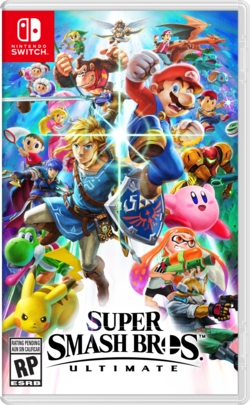 North American box art. | |
| Developer(s) | Bandai Namco Sora Ltd. |
| Publisher(s) | Nintendo |
| Designer(s) | Masahiro Sakurai |
| Projected release date | December 7, 2018 |
| Genre(s) | Fighting Platforming |
| Platform(s) | Nintendo Switch |
| Media | ROM Cartridge Digital distribution (Nintendo eShop) |
| Input methods | Joy-Con, Nintendo Switch Pro Controller, GameCube controller (via adapter) |
Super Smash Bros. Ultimate (大乱闘スマッシュブラザーズ SPECIAL, Great Fray Smash Brothers Special) is an upcoming fighting game for the Nintendo Switch. It was first announced on March 8th, 2018 at the end of the Nintendo Direct released the same day. It will be the fifth installment in the Super Smash Bros. series (sixth if both versions of Super Smash Bros. 4 are counted as two games). The game is scheduled to release on December 7, 2018.
Trailer
The first teaser trailer was revealed at the end of the Nintendo Direct on March 8th, 2018. Without explicitly confirming the playable status of any characters, the teaser trailer hinted that Inklings would be debuting in the game as newcomers, while also suggesting that Mario, Link, and several other series veterans would be returning.
Confirmed elements
Characters
All 63 characters (65 if the three different Pokémon of the Pokémon Trainer are treated as individual characters) from all previous Smash Bros. games return as playable characters. Inkling, with various Boy and Girl designs from the original Splatoon (as well as Splatoon 2), has been confirmed to appear in the game as a playable character. Ridley is also confirmed to be playable, with Meta Ridley as an alternate costume. Playable clone characters are now described as "Echo Fighters" and are marked with an epsilon symbol (ε); Daisy is confirmed to be an Echo Fighter of Peach. The roster initially starts with the Original 12 fighters from Super Smash Bros., while many other fighters are unlockable characters.
| Veterans (65) | |||||||||||||||
|---|---|---|---|---|---|---|---|---|---|---|---|---|---|---|---|
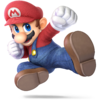 Mario |
 Luigi |
 Peach |
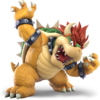 Bowser |
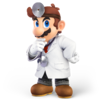 Dr. Mario |
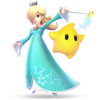 Rosalina & Luma |
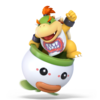 Bowser Jr. |
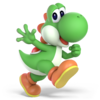 Yoshi | ||||||||
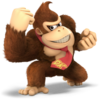 Donkey Kong |
 Diddy Kong |
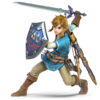 Link |
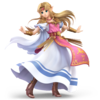 Zelda |
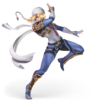 Sheik |
 Ganondorf |
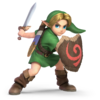 Young Link |
 Toon Link | ||||||||
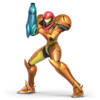 Samus |
 Zero Suit Samus |
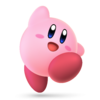 Kirby |
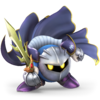 Meta Knight |
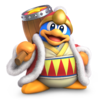 King Dedede |
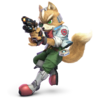 Fox |
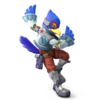 Falco |
 Wolf | ||||||||
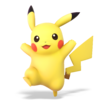 Pikachu |
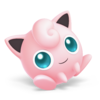 Jigglypuff |
 Mewtwo |
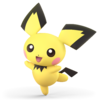 Pichu |
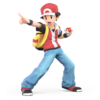  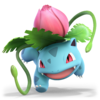 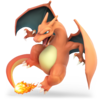 Pokémon Trainer (Squirtle, Ivysaur, Charizard) | |||||||||||
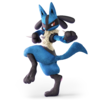 Lucario |
 Greninja |
 Captain Falcon |
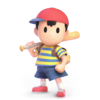 Ness |
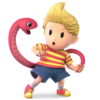 Lucas |
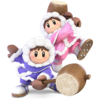 Ice Climbers |
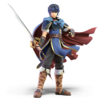 Marth |
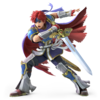 Roy | ||||||||
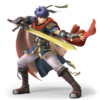 Ike |
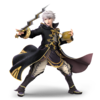 Robin |
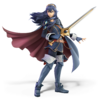 Lucinaε |
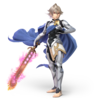 Corrin |
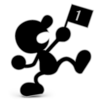 Mr. Game & Watch |
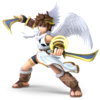 Pit |
 Palutena |
 Dark Pitε | ||||||||
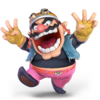 Wario |
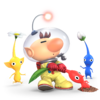 Olimar |
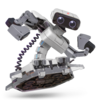 R.O.B. |
 Villager |
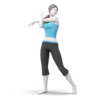 Wii Fit Trainer |
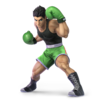 Little Mac |
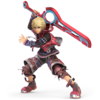 Shulk |
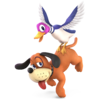 Duck Hunt | ||||||||
 Snake |
 Sonic |
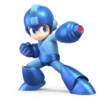 Mega Man |
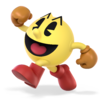 Pac-Man |
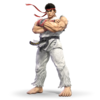 Ryu |
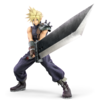 Cloud |
 Bayonetta |
|||||||||
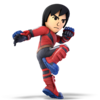 Mii Brawler |
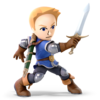 Mii Swordfighter |
 Mii Gunner |
|||||||||||||
| Newcomers (24) | |||||||||||||||
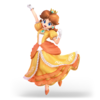 Daisyε |
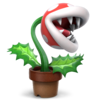 Piranha Plant (DLC) |
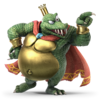 King K. Rool |
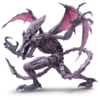 Ridley |
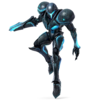 Dark Samusε |
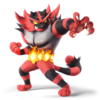 Incineroar |
 Chromε |
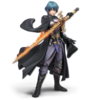 Byleth (DLC) | ||||||||
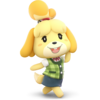 Isabelle |
  Pyra/Mythra (DLC) |
 Inkling |
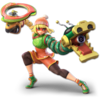 Min Min (DLC) |
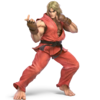 Kenε |
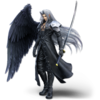 Sephiroth (DLC) |
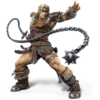 Simon | |||||||||
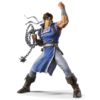 Richterε |
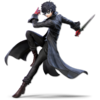 Joker (DLC) |
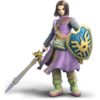 Hero (DLC) |
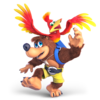 Banjo & Kazooie (DLC) |
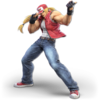 Terry (DLC) |
 Steve (DLC) |
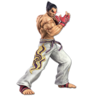 Kazuya (DLC) |
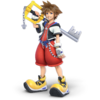 Sora (DLC) | ||||||||
Bold denotes starter characters.
"ε" denotes Echo Fighters.
Stages
New Items
- For the entire confirmed list of items, see Items page.
| Item | Type[1] | Heavy[1] | Notes | Universe |
|---|---|---|---|---|
| Banana Gun | Shooting | Ejects the banana out of the peel and the player is left with the banana peel after using it. | ||
| Black Hole | Throwing | Creates a massive black hole, dragging all items and players nearby in. Throws the opposite side of user's orientation. | ||
| Bomber | Special | Explodes in the player's hand when used, which only affects enemies. Will also explode after a short amount of time or if it falls off a ledge, affecting everyone. | ||
| Fake Smash Ball | Special | Flies around the stage, similar to the Smash Ball. Characters can break it in order to activate. Once broken, it will explode. | ||
| Healing Field | Throwing/Recovery | Can be thrown on the ground. Once thrown, it will open up and will heal anyone standing on it. | ||
| Launch Star | Throwing | Can be set in midair, where it will attract and launch any characters that get too close to it. The launch has the potential to KO fighters. |
Development
Towards the end of Super Smash Bros. 4's post-launch development, Masahiro Sakurai announced that his next project had been decided and that he would be taking a small vacation following the end of development.[2] Prior to leaving Bandai Namco, presumably sometime in 2016, Tiago Sonobe, then a software engineer and graphics programmer for the company, started development on the game's rendering engine. On November 12th, 2017, Nintendo filed a number of trademarks, notably including a Japanese Super Smash Bros. logo.[3]
A Super Smash Bros. title for Nintendo Switch was later officially revealed on March 8th, 2018 via a Nintendo Direct. Shortly after, Sakurai confirmed in a tweet that he had been working on the game "in silence, day after day".[4][5] On March 22nd, 2018, Nintendo announced the Super Smash Bros. Invitational 2018, a tournament taking place on June 12th where invited professional players will play the upcoming game. Later, in volume 542 of his Famitsu article, Sakurai revealed that his work schedule had been cut down significantly, citing strict regulations regarding work hours.[6] On April 18th, 2018, Nintendo again filed a number of trademarks for several game logos, including the Super Smash Bros. logo. Most of these game logos originate from games with some relationship to the Smash series, including Pikmin, Star Fox, and F-Zero. These trademarks were approved on May 14th, 2018.[7]
On June 12th, day 1 of Nintendo's E3 presentation, the first glimpse of actual gameplay was revealed on a Nintendo Direct and the preceding Nintendo Treehouse, alongside a demo of the game being released for play on Nintendo's E3 event. After the completion of the Super Smash Bros. Invitational, Nintendo released an Official Super Smash Bros. Ultimate Website, where information and updates to the game can be found. These include lists of future stages and items, alongside previews of music created for the game.
Changes from SSB4
As Super Smash Bros. Ultimate is still in development, the information listed below have been taken from the E3 Demo version and gameplay trailers, and may be subject to change in the final version of the game.
Menu and UI changes
- In Vs. mode, the stage selection screen now appears before the character selection menu, making players select a stage before selecting characters.
- This could be interpreted as fairer to the losing player in a set of matches.
- All stages now have a Battlefield form. Ω forms are also standardized to have the same underside shape akin to Final Destination, with none of them having vertical walls.
- Stage hazards can be turned off for the first time in the series, allowing players to remove intrusive elements from gameplay.
- What constitutes as a "hazard" is not yet clear, but seems to include even mild elements such as tilting or platform movement.
- Alternate costumes are now shown at the bottom of the player's portrait, with at least eight small stock icons representing each palette swap. Additionally, each color is now listed with a name from the numbers 1-8 (e.g. Color 5).
- In timed matches, characters in the lead will occasionally flash with a gold sparkle.
- While a match is loading, an intense versus splash screen will appear, showing the combatants in their CSS renders and alternate costume.
- Consequently, this seems to remove tips- at least from where they were in Smash 4.
- The damage meter now displays tenths of a damage percentage (e.g. 10.5%).
- Note that every Smash game since Melee used decimal percentages in calculations, but rounded them to whole numbers when displayed on screen.
- In one-on-one stock fights, the stock count of both fighters will be briefly displayed onscreen whenever a stock is lost.
- While a fighter is knocked off the stage, a minimap which shows the character locations, blast zone, and camera zoom will appear on the corner of the screen.
- The closer a fighter is to a blast zone, the smaller their "magnifying glass" camera becomes. It will start flashing when they are almost touching the blast line.
- Like Little Mac in Smash 4, several characters now sport additional UI elements next to their damage meter, such as Villager's Pocketed item, Robin's durability counters, or Inkling's Ink Tank gauge.
Gameplay changes
- To increase gameplay speed, all damage taken in a one-on-one fight is increased to 1.2x.
- While knockback itself might be unchanged, the physics of launch movement are different - characters have a much higher initial speed and deceleration, resulting in being launched at very high speeds yet slowing down to nothing very quickly.
- Rage only becomes noticeable when the opponent is at 120% or above, and its knockback increase has been toned down.
- Perfect shields are performed in reverse: instead of pressing the shield button several frames before an attack connects, players have to release the shield button when an attack connects on their shield instead. This also causes the screen to pause briefly, with the fighter's eyes flashing to signify a perfect shield. This updated mechanic allows a perfect-shielding fighter to retaliate much faster against attacks, though it is currently unknown if it forces shields to take damage before a player can retaliate.
- If two grabs collide, both characters take minimal damage and act as if grab released. This removes the effect of port priority in determining who gets the grab.
- Edge sweet spots have become smaller.
- Footstools have been nerfed, with opponents being able to tech on the ground during the footstool animation.
- Reeling can be teched on the ground, like in previous Smash games.
- Locks can now only be performed twice in a row.
- Characters can no longer run through shielding characters and instead push them backwards, preventing cross-ups or mixups revolving around positioning behind an opponent. This will most likely be removed as multiple sources state that it is indeed a bug.[citation needed]
- The grab invulnerability gained after being grabbed has returned, but characters will now flash yellow to indicate the period during which they cannot be grabbed again.
- Screen KOs are much faster, making them once again faster than Star KOs.
- Instead of Bob-ombs falling, Sudden Death consists of the screen slowly zooming in, making the blast zones gradually shrink. It also appears to have a fixed camera angle, and the screen progressively gets covered in aesthetic flames, starting with the corners.
- Timed battles can last 2 and a half minutes.
Mobility changes
- The universal jumpsquat timing of every character has been standardized to 3 frames.
- Rolling and sidestepping repeatedly now penalize the user by slowly causing grounded dodges to lag and lose intangibility frames, leaving them more vulnerable.
- Perfect pivoting can no longer be performed.
- Air dodges now act as a combination of Melee and Smash 4: airdodging to the left and right grant fighters a quick momentum boost in said direction, but without making them helpless. However, fighters can only air dodge once before landing, and the directional version has roughly a full second of ending lag.
- Fighters suffer from almost no landing lag should they attempt a standard air dodge too close to the ground; however, directional air dodges cause more landing lag.
- Unlike in Melee, wavedashing is impossible due to the new mechanics added to directional air dodging as well as increased landing lag. Wavelanding can still be performed, but it is less practical by comparison.
- Initial dashes seem to have been lengthened allowing some aspects of Dash-dancing to return. However, characters cannot turnaround until the entire dash animation has finished which drastically limits the precision and practicality of the technique.
Attack changes
- Characters can now perform any ground attack out of a run, including their neutral attack and tilt attacks. In previous games, only dash attacks, up smashes and special moves could be performed out of a run. Characters can also instantly turn around to input any grounded attack in the other direction, a technique unofficially named "Reversed Run Canceling" by fans.
- Landing lag has been significantly reduced in general.
- Rapid-jab neutral attacks no longer push the user off edges when hitting opponents.
- Smash attacks can be charged about three times longer than previous games. Unlike in previous games, the damage increase from charging caps after a set period, but knockback continues to increase until the move is unleashed.
- Aerial attacks can be performed while hanging onto a ladder, a property known officially as a "ladder attack".
- Pummels have been universally sped up, but deal less damage.
- Non-storable chargeable neutral specials can now be reversed right before they are unleashed.
- Taunts can now be canceled, and are performed much faster.
- The effectiveness of every tether recovery has been nerfed, as they cannot be performed out of airdodges, and the amount of getup is the same as regular up specials.
- Final Smashes are quicker, with versions granting a controllable transformation being removed, so players can return to fighting quickly. As a result, many fighters receive new Final Smashes or have returning Final Smashes with altered functionalities, such as Landmaster being replaced by an Arwing cutscene, and Octopus dragging opponents offstage immediately after transforming.
Aesthetic changes
- The particle effects of the game are significantly more cartoony, with a solid-color or cel-shaded aesthetic. Compared to Smash 4, hits are signified by spark-like blows instead of colorful stars, while attack effects appear visually longer-lasting or possess far larger particle effects.
- Most returning fighters feature a more subdued color scheme, but with slightly more detail in their models than from previous games.
- Time slows down with a colorful blue background upon landing very strong hits or significant moments of a match, such as landing a fully-charged Giant Punch or when breaking a shield. The camera also does this for potential final hits of a match, dramatically pausing gameplay with intense sound effects and red lightning from the previous game, while zooming in.
- Punching and kicking SFX on hit are different and sound harder-hitting compared to the previous game, with even weaker attacks playing loud "punch" effects.
- Fighters sent flying now leave a colorful, lingering trail of solid-colored smoke behind them. If dealt enough knockback, they will also play a whistling sound while flying, akin to a jet plane.
- All characters now have unique hitstun animations for taking hits from behind.
- Blast KOs cause a burst of confetti on the screen alongside the standard colorful blast.
- Star KO'd characters now use a tumbling animation similar to Brawl's Screen KOs, rolling away from the screen as they fly away.
- Final Smashes now cause a segment of the screen to show the "eyes" of the fighter's official art before the move begins, similar to Chrom's appearance in Pair Up.
- In Mr. Game & Watch's case, the close up is of where his eyes would be.
- Any characters standing too close to the Final Smash will visibly react to it.
- While on Final Smash standby, the character's percentage gauge will constantly spark with aqua-colored electricity. Upon use, one of the eyes on the fighter's character portrait will flash.
- Many Assist Trophies and Final Smashes now affect the background of the stage.
- Victory scenes appear identical to the ones in the previous installment. However, the winner's area now takes place on this game's Battlefield. Additionally, while playing Team Battles, all teammates will perform their complete victory animation instead of only the player with the highest score/stock count, much like the first three games.
- On the victory screen, the Announcer will announce "(Character name) wins!" instead of "The winner is... (character name)!".
- In addition to some characters with a mirrored stance, some Assist Trophies and Poké Ball Pokémon face the screen regardless of the direction they turn towards.
- Names now override some instances of character names, such as underneath the damage meter.
- If the player enters a name, any Poké Ball Pokémon or Assist Trophy character summoned by the player will be indicated by the player's name.
Item changes
- There can now be more than one Assist Trophy active at any given time. Additionally, characters summoned by an Assist Trophy can be KO'd, granting a point to whoever KO'd said character. If multiple players summon an Assist Trophy each, they will proceed to fight one another if close enough.
- When an Assist Trophy or Poké Ball is used at the edge of a stage or ledge, they no longer immediately fall off the stage/ledge.
- Smash Balls have a chance of spawning with Soccer Ball physics, rolling around the stage and respawning once they drop offstage. These despawn after a set time.
- Fake Smash Balls were introduced, with inverted lines as their design. When broken, these explode into a colorful X-shaped explosion, causing heavy knockback and damage to nearby fighters. Unlike the standard Smash Ball, Fake Smash Balls tend to drift towards players and general action instead.
- The Boss Galaga causes a black background to cover the screen when it catches an opponent, complete with pixel stars. Additionally, if the Boss Galaga Star KOs a character, it can now be seen with the character in the distance. The star also becomes larger.
- The Hammer and Golden Hammer have a unique 8-bit-styled hit particle, resembling the particle effect used when Mario destroys a barrel in the original Donkey Kong.
- The Warp Star's descent can now be stalled by the user.
- The Timer now creates a dark warping background alongside its usual slowdown effect.
Gallery
Miscellaneous
- SSBU Panoramic.jpg
Panoramic Artwork
Characters
Trivia
- This is the first Super Smash Bros. game since the original Super Smash Bros. to not be announced alongside new hardware. Super Smash Bros. Melee was revealed alongside the final retail version of the Nintendo GameCube at E3 2001; Super Smash Bros. Brawl was announced alongside the Wii itself, then-codenamed Revolution at E3 2005; and Super Smash Bros. 4 was announced alongside the Wii U at E3 2011. Moreover, unlike the latter two games, this is the first time since Super Smash Bros. Melee that a Smash Bros. game is not announced years in advance, as Super Smash Bros. Brawl was announced in 2005 and revealed a year later, and Super Smash Bros. 4 was announced in 2011 and revealed two years later, with both released in 2008 and 2014 respectively.
- This is the first Super Smash Bros. game to:
- Not feature the involvement of Satoru Iwata as he passed away in July of 2015.
- Have no veteran characters cut since Melee.
- Have a planned simultaneous worldwide release.
- Have the announcer's voice actor unchanged, with Xander Mobus reprising his role from Super Smash Bros. 4.
- Feature unlockable characters and only one newcomer on the box art.
- Have all of its veterans announced prior to launch.
- In addition, Ultimate is the only Super Smash Bros. game in which all veteran fighters were confirmed on the same day and none of the newcomers are starter characters.
- Because of the size of the USK icon on the game's box art, the German version has a slightly different variation of said box art: Pikachu is moved upwards, Yoshi is completely missing, and the logo is off-centered.[8]
- Super Smash Bros. Ultimate marks the first time in the series where long-running veterans Peach, Bowser, Ice Climbers, Zelda, Sheik, Meta Knight, Pit, Zero Suit Samus, Ike, Charizard, Diddy Kong, King Dedede, and Olimar are unlockable characters.
- The Ultimate logo features the same curved line under the game title as Super Smash Bros. 4, though it is no longer hidden behind the series name.
- Ultimate's release date falls one day after the late Satoru Iwata's birthday, December 6 (which was also the release date of Super Smash Bros. for Wii U in Japan).
References
- ^ a b Types of items
- ^ "Famitsu News — “Sakurai Catching a Breather”" - Source Gaming.
- ^ “Nintendo Apply for a Number of Trademarks” - Japanese Nintendo.
- ^ Sakurai announces that he has been working on Smash for Switch.
- ^ Translation of Sakurai's Smash for Switch tweet.
- ^ "“Compliance and Labor” – Sakurai’s Famitsu Column, Vol. 542" - Source Gaming.
- ^ Several trademarks from Nintendo are approved for use.
- ^ https://twitter.com/ZeldaUniverse/status/1009908072205160450
External links
| Super Smash Bros. series | |
|---|---|
| Super Smash Bros. · Super Smash Bros. Melee · Super Smash Bros. Brawl · Super Smash Bros. 4 (for Nintendo 3DS · for Wii U) · Super Smash Bros. Ultimate |

























































































































